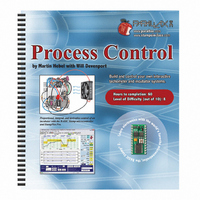122-28176 Parallax Inc, 122-28176 Datasheet - Page 300

122-28176
Manufacturer Part Number
122-28176
Description
GUIDE STUDENT PROCESS CONTROL
Manufacturer
Parallax Inc
Specifications of 122-28176
Accessory Type
Manual
Product
Microcontroller Accessories
Lead Free Status / RoHS Status
Contains lead / RoHS non-compliant
For Use With/related Products
Propeller Education (PE) Kit
Lead Free Status / RoHS Status
Lead free / RoHS Compliant, Contains lead / RoHS non-compliant
- Current page: 300 of 330
- Download datasheet (11Mb)
ACTIVITY #5: PROPORTIONAL-INTEGRAL CONTROL
Parts required:
Same as Activity #1
So far we’ve looked at what occurs when quick disturbances occur to our system in
equilibrium. Proportional control may be used to drive the temperature back to the
desired setpoint. But what happens when the disturbance affects the equilibrium of our
system over a long period of time? At the end of the last experiment, we saw what occurs
when the bias drive is not sufficient to make-up for average losses. Because some error
must exist for proportional drive, the setpoint temperature cannot be maintained.
Integral control can be used to drive-away any error remaining due to long lasting
disturbances or imbalances in the system. These errors may be from additional losses or
gains of energy that remain for a long period of time. Consider our incubator. We found a
bias temperature at which a 50% bias drive was sufficient to make up for the losses in the
system, maintaining it in equilibrium.
But what would happen if the room temperature were 10 degrees cooler? Continuous
system losses would be higher. The 50% bias drive will be insufficient to maintain the
temperature, and proportional drive will respond to the error in an attempt to drive the
system back toward to the setpoint with a steady-state error remaining. The system will
stabilize at a temperature below the desired setpoint. Over time, integral control can be
used to drive away this error, allowing the temperature to reach the setpoint.
Integral drive is also used when a slow approach with long stabilization times are needed
to ensure no overshoot. Consider the example of cooking soup. After cooking a bit, you
taste, add an amount of salt you feel appropriate for what you would like the final taste to
be. Do you taste immediately and add more? No, you wait a while to allow the salt to
blend in, then taste, and add a bit more until you finally reach your desired taste. What if
too much salt is added? Cutting back is a bit more difficult!
Co
%Drive
PID
= B + (K
TOTAL
= %Drive
P
E) + (K
BIAS
I
ΣE∆t)
+% Drive
PROP
+ %Drive
INT
Related parts for 122-28176
Image
Part Number
Description
Manufacturer
Datasheet
Request
R

Part Number:
Description:
MANUAL FOR SUMOBOT
Manufacturer:
Parallax Inc
Datasheet:

Part Number:
Description:
GUIDE STUDENT SMART SENSORS
Manufacturer:
Parallax Inc
Datasheet:

Part Number:
Description:
MANUAL PROPELLER
Manufacturer:
Parallax Inc
Datasheet:

Part Number:
Description:
LEAD WIRES FLYING CABLE III/IV
Manufacturer:
Xilinx Inc
Datasheet:

Part Number:
Description:
BOARD ADAPTER AND FLY LEADS
Manufacturer:
Xilinx Inc
Datasheet:

Part Number:
Description:
PLATFORM CABLE USB II
Manufacturer:
Xilinx Inc
Datasheet:

Part Number:
Description:
KIT STARTER COOLRUNNER-II BUNDLE
Manufacturer:
Xilinx Inc
Datasheet:

Part Number:
Description:
Microcontroller Modules & Accessories DISCONTINUED BY PARALLAX
Manufacturer:
Parallax Inc

Part Number:
Description:
Microcontroller Modules & Accessories DISCONTINUED BY PARALLAX
Manufacturer:
Parallax Inc

Part Number:
Description:
BOOK UNDERSTANDING SIGNALS
Manufacturer:
Parallax Inc
Datasheet:

Part Number:
Description:
BOARD EXPERIMENT+LCD NX-1000
Manufacturer:
Parallax Inc
Datasheet:

Part Number:
Description:
IC MCU 2K FLASH 50MHZ SO-18
Manufacturer:
Parallax Inc
Datasheet:












